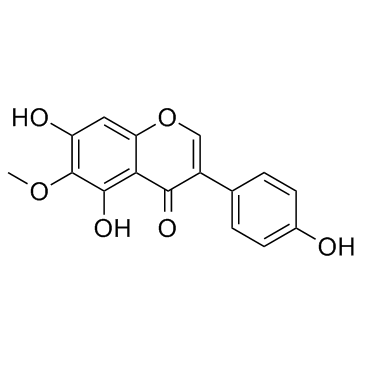Home
Products
Tectorigenin



| Product Name | Tectorigenin |
| Price: | $46 / 20mg |
| Catalog No.: | CN05473 |
| CAS No.: | 548-77-6 |
| Molecular Formula: | C16H12O6 |
| Molecular Weight: | 300.26 g/mol |
| Purity: | >=98% |
| Type of Compound: | Flavonoids |
| Physical Desc.: | Powder |
| Source: | The rhizomes of Belamcanda chinensis (L.) DC. |
| Solvent: | Chloroform, Dichloromethane, Ethyl Acetate, DMSO, Acetone, etc. |
| SMILES: | COc1c(O)cc2c(c1O)c(=O)c(co2)c1ccc(cc1)O |
| Contact us | |
|---|---|
| First Name: | |
| Last Name: | |
| E-mail: | |
| Question: | |
| Description | Tectorigenin is a plant isoflavonoid originally isolated from the dried flower of Pueraria thomsonii Benth. |
| In Vitro | Tectorigenin is a plant isoflavonoid originally isolated from the dried flower of Pueraria thomsonii Benth. Palmitic acid (PA)-stimulated ROS production is abolished by treatment with Tectorigenin for HUVECs in a dose-dependent manner (0.1, 1, 10 μM). Treatment with Tectorigenin attenuates enhanced IKKβ phosphorylation and effectively blocks NF-κB activation by inhibition of p65 phosphorylation at concentrations ranging from 0.1 to 10 μM. Tectorigenin treatment also effectively inhibits PA-augmented TNF-α and IL-6 production in a concentration dependent manner[1]. The number of viable HepG2 cells treated by Tectorigenin decreases in a concentration- and time-dependent manner. When HepG2 cells are treated with Tectorigenin at 5, 10 and 20 mg/L for 24 h, the viability rate is 91%, 79% and 62%, respectively[2]. |
| Cell Assay | Cell viability is assessed by MTT method. Briefly, cells are seeded in 96-well plate at a density of 1×104 cells/well. After 24 h incubation, Tectorigenin at different concentrations is added to the cells while only DMSO (solvent) is added as a negative control. After growing for 12, 24 and 48 h, cells are incubated with MTT (0.5 mg/mL) for 4 h at 37°C. During this incubation period, water-insoluble formazan crystals are formed, which are dissolved by the addition of 100 μL/well DMSO. The optical densities at 570 nm are measured using an enzyme-linked immunosorbent assay plate reader. Wells containing culture medium and MTT but no cells act as blanks[2]. |
| Density | 1.512 |
| Boiling Point | 601.5±55.0 °C at 760 mmHg |
| Flash Point | 230.1±25.0 °C |
| Exact Mass | 300.063385 |
| PSA | 100.13000 |
| LogP | 2.54 |
| Vapour Pressure | 0.0±1.8 mmHg at 25°C |
| Storage condition | 2-8°C |